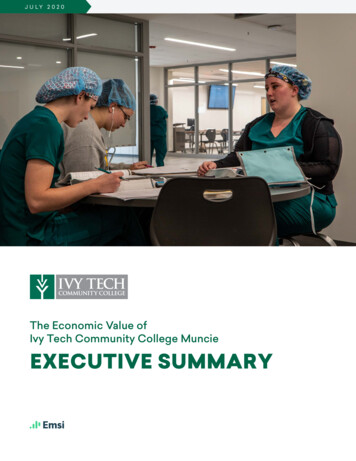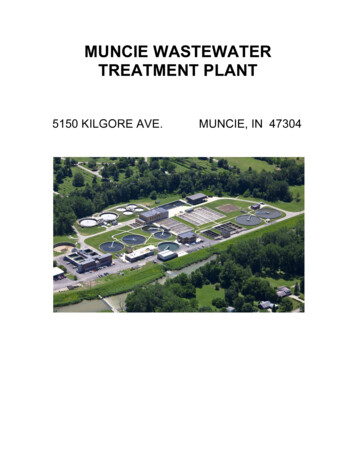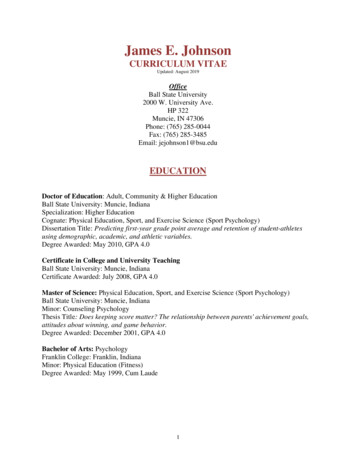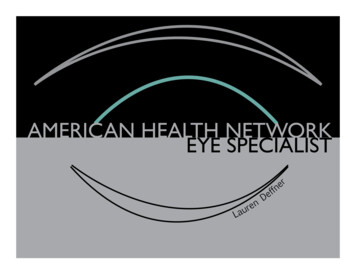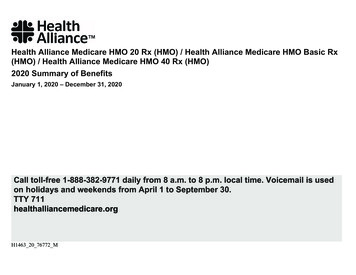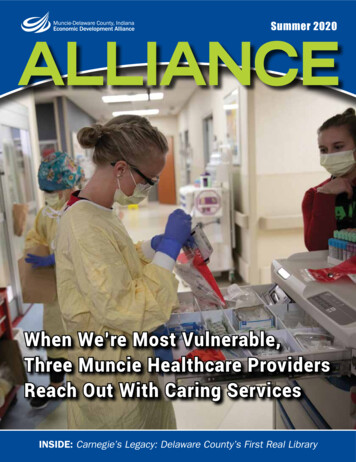
Transcription
Summer 2020ALLIAALLIANCENCEWhen We’re Most Vulnerable,Three Muncie Healthcare ProvidersReach Out With Caring ServicesINSIDE: Carnegie’s Legacy: Delaware County’s First Real Library
FOR -ADPR-ALLIANCE-0919COMMERCIAL BANKINGCOMMERCIAL BANKING PERSONAL BANKINGPERSONAL BANKING P R I VAT E W E A LT HP R I VAT E W E A LT 9Somehow, life got faster. We understand. When you need nimble, First Merchants is ready to roll. When you needSomehow, life got faster. We understand. When you need nimble, First Merchants is ready to roll. When you needa foundation, we’re your bedrock. So if you’re a go-getter, an up-and-comer or an early riser, First Merchants cana foundation, we’re your bedrock. So if you’re a go-getter, an up-and-comer or an early riser, First Merchants canprovide the tools to make your life as efficient as possible. For more information go to firstmerchants.com.provide the tools to make your life as efficient as possible. For more information go to firstmerchants.com.firstmerchants.com 765-213-3493765-213-3493firstmerchants.comDeposit accounts and loan products are offered by First Merchants Bank, Member FDIC, Equal Housing Lender.Deposit accounts and loan products are offered by First Merchants Bank, Member FDIC, Equal Housing Lender.First Merchants Private Wealth Advisors products are not FDIC insured, are not deposits of First Merchants Bank, are not guaranteed by any federalFirst Merchants Private Wealth Advisors products are not FDIC insured, are not deposits of First Merchants Bank, are not guaranteed by any federalgovernment agency, and may lose value. Investments are not guaranteed by First Merchants Bank and are not insured by any government agency.government agency, and may lose value. Investments are not guaranteed by First Merchants Bank and are not insured by any government agency.
MUNCIEBuilding From a Solid FoundationWe build locally because wework, live and serve locallyGeneral Contractor Site Development Construction Management Design Build Architectual & Interior Design421 S. Walnut St. Muncie, IN 47305 765-284-3833 www.pridemarkconstruction.com3 ALLIANCE SUMMER 2020
A WORDChallenging situations have a way of revealing thebest in people and the organizations they serve.All across our community, in the cities, towns andtownships, there’s a pronounced unification of purpose.That purpose is compassion.Leading the charge in this battle of beneficence are threeMuncie-based healthcare organizations whose employeesreach into the lives of our community’s less fortunate,offering helpful, healing services that together enhance ourcollective well-being on a daily basis.There is Open Door HealthServices, Meridian Health Servicesand IU Health Ball MemorialHospital’s new Addiction Treatmentand Recovery Center. Combined,these three organizations have staffsthat are actively assisting broadswaths of our community on avariety of health fronts.JAY JULIANWe’ll also talk about how theChief EconomicCOVID-19 pandemic is affectingDevelopment Officer,the delivery of medicine in ourPresident/CEOcommunity.On the lighter side, this issue ofAlliance shares the very interesting history of the MunciePublic Library’s first stand-alone location: the Carnegiebranch. Not only that, but we’ll also detail the early,formative years of Muncie’s library system.But, the real flavor lies in the Carnegie building itself.We think you’ll delight in discovering all the tasty, littletidbits of lore that surround that beautiful downtownstructure.Another of our community’s older recreationalestablishments is the subject of yet another Hidden Gemstory: the Delaware Country Club. Located on Muncie’sfar east side, the Country Club has been around forgenerations and was founded by some well-known names.Find out the club’s history and what’s been going on outthere lately.Last, but not least, is our ever-popular HomewardFound section in which we shed light on a MuncieDelaware County native, as well as two who grew upelsewhere, but now call our community home.We selected these stories and charted our course for thisedition of Alliance prior to the pandemic. We already sawthe importance of local healthcare providers, but clearlytheir work is more important now than ever.Indeed, these are challenging times. But, have a seat andtake a few minutes to read this interesting publication.Some of our community’s best work is revealed within. u4 ALLIANCE SUMMER 2020PO Box 842, 401 S. High St., Muncie, IN 47308765-288-6681 800-336-1373PROFESSIONAL STAFFJay JulianChief Economic Development Officer(765) 288-6681jjulian@muncie.comTraci LuttonVice President, Economic Development(765) 751-9126tlutton@muncie.comAshley SurpasProject Manager(765) 751-9116asurpas@muncie.comALLIANCETHE MAGAZINE OF THEPUBLISHERJay JulianMuncie-Delaware County, IndianaEconomic Development Alliancewww.muncie.comEDITORAshley SurpasMuncie-Delaware County, IndianaEconomic Development Alliancewww.muncie.comADVERTISING SALESMark Di FabioAccount Executive, Woof Boom Radiowww.woofboom.comDESIGN AND EDITORIAL DIRECTIONLayout and design by Carol Johnson.ALLIANCE MAGAZINE:The voice of the Muncie-Delaware County, IndianaEconomic Development Alliance. These materialsare the sole and exclusive property of theMuncie-Delaware County, Indiana EconomicDevelopment Alliance and may not be usedwithout written consent.Copyright 2020The Muncie-Delaware County, IndianaEconomic Development Alliance
IN THIS ISSUESUMMER 2020Features126Inside20On the Cover6Pandemic DrivingTele-Medicine12Local HealthcareProviders TackleCommunity Needs20Carnegie’s Legacy StillThriving HereOur healthcare storiesappear on pages 6-18.SUMMER 2020 ALLIANCE 5
Tele-Medicine a Real Cure for PatientsUnable to Visit DoctorLocal Healthcare Providers Detail Massive Growth in Online VisitsHospitals and clinical practices around the globehave been rocked by the COVID-19 pandemic.Those that haven’t been inundated by thoseactually suffering from the virus have been hit with amammoth new reality: personal visits are out for themost part, while tele-medicine is emerging as the solealternative to building-based healthcare delivery.According to an article in the April 2020 edition ofthe medical journal The Lancet, physicians in China’sWuhan province, where COVID-19 emerged, urgedinfected patients to contact care providers online.That practice served as a model for other countrieswho began seeing a surge in infected citizens. Today,virtualized approaches to medicine are ubiquitous inthe face of a pandemic that has millions abiding by stayat-home and social distancing orders. No one, least ofall healthcare delivery workers, wants to get infected,and that reality is driving so-called tele-health.Eric Tharp, Vice President, Chief Practice Officer forIU Health’s East Central Region, said tele-medicine andvirtual healthcare visits are a rapidly growing segmentin his region. He said IU Health is utilizing expandedfederal rules regarding tele-medicine to help stayconnected to patients and provide them with somepeace of mind during an uncertain time.Tharp said while much of the equipment necessaryfor a higher volume of tele-health visits was alreadyin place, the training for physicians and education forpatients on how to use the technology is still ongoing.“We have increased our time investment for sure,”Tharp said in regard to its growing tele-health strategies.“Patients already know what to expect with an in-personphysician visit. But, they may have never experienceda virtual visit before. They might need help trying toopen links they’ve been provided. There are definitelydifferent challenges for different patients. We’ve spent6 ALLIANCE SUMMER 2020a lot of time getting patients educated on how they’llbe contacted and the technology associated with that.We’re also working to help physicians understand someof these things.”A major factor in tele-health’s rapid, virus-drivengrowth was a move by the federal Centers for Medicareand Medicaid Services (CMS) to dramatically easerestrictions relating to virtual healthcare delivery.According to The Lancet, in late March, CMS officialsannounced an “an unprecedented array of temporaryregulatory waivers and new rules to equip the Americanhealthcare system with maximum flexibility” to respondto the pandemic.Tharp said one such regulation change now allowsphysicians in one state to conduct tele-health visits withpatients across state lines, something strictly prohibitedin the pre-pandemic rule book.While it seems tele-health has successfully bridgedthe gap between doctor and patient, there are, of course,drawbacks. The most obvious, Tharp said, is the physicalcomponent.“We can’t do physical exams, and that means we can’tuse our instruments to help determine a patient’s health,”said Tharp. “For example, we are unable to look into apatient’s throat or into a patient’s ears. We can’t listen totheir heartbeat. There are definitely limits to what telehealth can do. But, it’s still important that we’re able tooffer our patients some assurances. That’s why routinecheckups, even if they’re done virtually, allows us to buysome time until we feel like we really need to see thatpatient in person.”The shortcomings of tele-health are also apparentfor Linda Daniel, program director for IU Health BallMemorial’s Addiction Treatment and Recovery Centerin Muncie. Daniel’s patients, who come into her IntensiveOutpatient Program (IOP) already detoxified and readyto get on with their drug-free lives, rely on the facility’s
addiction recovery community forhelp and guidance.That community is now largelyfragmented and absent in the faceof stay-at-home orders and socialdistancing. Daniel lamented theclosure of the popular lobby areaand adjoining kitchenette, wherepatients once convened over snacks,coffee and conversation, drawingstrength and perseverance from oneanother.“They no longer have that,” Danieltold Alliance. “But, if we can stillcommunicate and connect withthem via tele-visits, that’s good, too.”Yet, Daniel said, the online therapyand connectivity is only valuablefor patients who have access to thattechnology. “Some may not have asmart phone, computer, or maybe even a telephone,”she said.Patients’ access to technology, however, is oftenbeyond healthcare providers’ control. Hank Milius,CEO of Meridian Health Services, tries to address theissue by enhancing patient accessibility to tele-visits onMeridian’s end. “We’re not making a huge investment inthe technology,” Milius told Alliance, “but, we’re beefingit up much more. We’re adding more technology atdifferent sites and that is increasing patients’ accessibilityto tele-visits.”For Meridian, the technology investment has beenthere for five years, which is how long it’s been offeringtele-health services. But, Milius said, no one could’veforeseen the explosion in tele-medicine prior toCOVID-19.“In April of 2019, we did just under a thousand televisits,” he said. “In April of 2020, we did 33,000!”“Overall, tele-medicine has been a positive experience,especially in light of COVID-19. People don’t want totake the risk of visiting a healthcare facility.”Milius offered an anecdote that illustrated the valueof tele-health, particularly for older, more vulnerablepeople.“We have one provider in Richmond,” he said, “whobasically has to teach his older patients how to do Zoom,as an example. That sounds tedious, but once theyget the hang of it, it opens up a whole new world forthem. Obviously, this isn’t much of an issue for youngergenerations. But, for older patients, the technology canbe frustrating. Since physicians usually have an ongoingrelationship with their patients, it makes it easier forthem to accept tech advice. They walk through theprocedures together, and patients end up enjoying it.It’s all new to them, so of course people are going to beskeptical. But, once you learn it, you feel empowered;you feel confident.”Milius said the lifting of some federal tele-medicineregulations has enabled healthcare providers to getreimbursement for such visits from Medicare andMedicaid. Prior to those changes, a large swath of onlinemedicine wasn’t eligible for reimbursement.Milius predicted a brighter future for tele-health, evenif the pandemic eases and rules are reinstituted.“There’s no turning back now,” he said. “It might bemore restrictive in the future, but we’ve had such apositive response I doubt we go back to the old ways.” uSUMMER 2020 ALLIANCE 7
Next Door Neighbors IU Health Ball MemorialHospital and Ball State University UseProximity to Boost New ProgramsB/MD Pathway Puts Undergrads on Path to Medical SchoolLocation! Location! Location!Primary project launched by the hospital and theProximity means everything to a new program school of medicine and paid for by a cluster of grantsthat relies on cooperation between next door from the Ball Brothers Foundation.neighbors Ball State University and IU Health BallOptimus Primary was launched after a 2016 studyMemorial Hospital.illuminated an alarming disparity in Muncie-DelawareThe beneficiaries of the close-knit B/MD PathwayCounty: the county ranked fourth in per capitaprogram are East Central Indianaprimary care physicians, but 87th inhigh school seniors who are serioushealth outcomes, or the impact ofabout attending medical school. Byhealthcare activities on citizens. Inembarking on the Pathway, guided byshort, officials discovered they haveacademic advisors, students who meeta lot of physicians in the community,the program’s requirements will earnbut the citizens are not as healthy asa provisional seat in the IU School ofother communities.Medicine-Muncie.They set out to change that withThe B/MD Pathway doesn’t result inOptimus Primary as their principala degree. Rather, it helps keep studentstool. The long-term program envion the path to medical school throughsions a community in which morecommunity-based advising and exlocally-educated primary care phytracurricular activities in the localsicians are retained, offering citizenshealthcare scene.better access to healthcare that focusDr. Derron Bishop, Associatees on prevention and wellness.Dr. Derron BishopDean of the IU School of Medicine –The B/MD Pathway is just one ofMuncie, said this guided pathway willthe mechanisms being initiated tobe particularly valuable here since the hospital and achieve those goals. Bishop cited some encouraginguniversity are next door to one another.statistics that underpin the need for such a program.“The close proximity makes it easier to develop“If we take a local person - who grew up here - andprogramming between the hospital, the clinics, andwe train them locally, there’s an 80 percent chancethe university,” Bishop told Alliance. “It’s also morethey’ll practice within 50 miles of where they do theirconvenient for students.”residency,” he said. “According to our own internalBishop said the B/MD strategy didn’t just fall out ofdata, if we train a local person, our odds of keepingthe sky as a new idea. It’s an offshoot of the Optimus them here are very high.”8 ALLIANCE SUMMER 2020
Plus, Bishop said, those future physicians can betrained in ways that support the Optimus Primarymission of fundamentally altering local healthcare infavor of preventative medicine, wellness and overallcommunity health.“One thing we will do is build into these studentsthe tenets of Optimus Primary - things like lifestylemodification and behavioral science,” he explained.“We can inculcate them and their thinking asundergraduates, so when they come to medical schoolit’s already part of their fabric. They can come tomedical school with our way of thinking about how tochange medicine.”Bishop also touched on the positive economics ofretaining local physicians. He cited a Tripp Umbach &Associates study that revealed the financial benefits oflocal medical practices.“They ran the numbers,” he said. “Each doctor thatestablishes a practice in the state generates 1.5 millionannually in economic impact. Moreover, each practicecreates six or seven additional jobs; and each practicegenerates an average of 300,000 in annual regionaltax revenue. Also, each doctor who has a primarycare practice in an under-served area generates 3.6million in healthcare utilization savings.”He defined healthcare utilization savings as moneysaved by people going to a doctor instead of anemergency room, or simply the process of doingpreventative medicine to prevent hospitalization.Although the COVID-19 pandemic brought anabrupt end to this school year, Bishop said the B/MDPathway program is already underway, with a coupleof students already enrolled. He’s been meeting witharea school superintendents and guidance counselors,getting news of the program out to students who areserious about attending medical school."If we take a local person - who grew uphere - and we train them locally, there’s an80 percent chance they’ll practice within50 miles of where they do their residency."– Dr. Derron BishopPotential Pathway participants are interviewed andscreened, and admitted students always have thechoice of opting out of the program if it’s not workingout, Bishop said.“I’m really happy this program is up and running,”he said. “We have a lot of smart, talented high schoolseniors whom we’d like to get on the path to medicalschool in Muncie. Because of this partnership, we’reable to train them in ways that will help them be moresuccessful going into medical school. It won’t be a bigshock for them when they get there; they’ll alreadyknow what it’s all about.”Bishop said a total of eight B/MD Pathway seatswill be filled by students from East Central Indiana.The program will ramp up in earnest next schoolyear. uSUMMER 2020 ALLIANCE 9
New Muncie Addiction Treatment and RecoveryCenter Underscore’s IU Health’s Commitmentto Battling Back Against Opiod EpidemicAn explosion in drug addiction is driving aIt’s no secret Muncie-Delaware County has been hardstatewide push by IU Health to offer addictionhit by various addiction crises, including but not limitedtreatment and recovery services. That effort tookto prescription opioids, methamphetamine, and alcohol.root in Muncie last year when IU Health Ball MemorialIn fact, the groundswell of addiction is what motivatedHospital (BMH) launched its Addiction Treatment andIU Health to expand addiction treatment services in theRecovery Center (ATRC) at 210 N. Tillotson Ave.first place.Situated in the former home of an OB/GYN clinic,Indiana University researched the trend and discoveredthe center is led by Linda Daniel, a PhD who’s a licensedan alarming statistic: two out of three Hoosiers knowHealth Service Provider in Psychology. An employeesomeone who is struggling with addiction.at BMH for 15 years, she completedThat spurred IU Health to invest in andher doctoral fellowship in the hospital’sseek philanthropic assistance for a majorneuropsychology unit, a part of the facility’sstatewide initiative aimed at curbingphysical rehabilitation department whichaddiction. Since 2018, the healthcareshe also directed for a time.company has established ATRCs not onlyThere, Daniel oversaw treatment ofin Muncie, but in Avon, Martinsville,patients with dementia, traumatic brainIndianapolis, and Bloomington, with ainjuries, strokes, etc. Then she switchedLafayette location forthcoming.gears, moving over to the family side of“Completion rates within thesemedicine in the hospital’s residency clinic.programs,” the IU Health website says, “areHer work there revolved around deliveryabove the national average of 40 percent,of compassionate care. “Part of our focuswith some programs showing completionwas bedside manner. We wanted to treatrates above 90 percent.”patients like people instead of treatingAccording to Daniel, ATRC’s successLinda Danielthem like diseases,” Daniel said.rate is borne of a comprehensive treatmentBeing the hospital’s only psychologist, Daniel wasapproach, combining physical, behavioral and socialthen offered the opportunity to lead the newly-formedaspects of patient health. The Center also employs a PeerAddiction Treatment and Recovery Center.Recovery Coach, or a former addict who helps counsel“I said, ‘I’ll give it a shot!’,” Daniel told Alliance.current addicts.“Addictions have never been a primary focus for me.“Our peer recovery coach is Bill Rogers, a recoveringAddiction was always on the side and never a primaryalcoholic,” Daniel said. “It’s important to have someonediagnosis. So, I hadn’t had much experience with it, but Iwith ‘lived experience.’ Bill is a trained biologist with awas willing to give it a go.”PhD, and that helps patients understand addictions as aJuly will bring the Center’s one-year anniversary. Priordisease and not just a moral failing or a character flaw.to the pandemic, Daniel said the facility was alreadyHe has been instrumental in helping patients. They lookapproaching capacity, even after only a few months ofup to him. They see that they can get out of living inoperation.addiction and move into recovery.”Daniel also credited Fran Wehlage, the Center’s10 ALLIANCE SUMMER 2020
recreational therapist, with providing a critical key inaddiction recovery: fun.“Fran helps make our program different and unusual,”Daniel explained. “She helps people learn how to enjoythemselves again. In addiction, you forget how to havefun without a particular substance. So Fran organizesexcursions and patients might get to go to Ball State’sDavid Owsley Museum of Art or Christy Woods – justso they can learn to enjoy life again.”Another critical factor in the Center’s success hasbeen its policy of not accepting patients into IntensiveOutpatient Programs (IOP) who aren’t yet ready toendure them. IOPs involve long, group therapy sessionsof about 15 people. Sessions often last three hours andoccur three times weekly. Patients still in the throws ofactive addiction, Daniel said, aren’t prepared for IOPsand cannot be accepted – yet.“Our program isn’t going to meet the needs of someonewith an active addiction,” she said. “Their thinking is stilltoo cloudy.”Daniel offered an all-too-real hypothetical.“If someone shows up at the emergency room andthey’ve just overdosed and they want to get their livesturned around . if we can’t see them immediately, welose them back to addiction,” she explained. “If they’reactive in their addiction, they need to detoxify before theycome to us. We don’t do detoxification. They need to getdetoxed and then, after 3-4 weeks of inpatient treatment,they’re ready for individual outpatient sessions.”Though the Center’s protocols prevent acceptance ofthose with still-active addictions, Daniel and her staffare nevertheless trying to bridge that gap by initiatinga hybrid program that extends therapy to those inadvanced stages of detoxification.The Center’s new “pre-care” group welcomes partiallydetoxified recovering addicts who can sit through aboutan hour of group therapy one day a week.“We try to get them strong enough for the IOPprogram,” said Daniel. “We can get them medicationsto address their cravings, but they must have therapy togo with the medications. We can’t just give medicationswithout therapy. We need to build up their stamina sothey’re able to sit through IOPs.”Daniel said the difference between the pre-careprogram and the IOPs is very pronounced.“In the pre-care program,” she said, “our patients arestraddling the fence of recovery and addiction. Peoplewho come to IOPs want recovery; they want to avoidrelapse. They want to thrive instead of just survive.”For many patients, the Center’s services also offer acrucial bridge to primary care – something many addictsgo without for long periods, according to Daniel. It’s atthis juncture that ATRC’s mission intersects with thegoals of the Ball Brothers Foundation’s Optimus Primaryprogram, which seeks to improve the entire community’shealth and well-being by providing greater citizen accessto primary care providers."Completion rates within these programsare above the national average of 40percent, with some programs showingcompletion rates above 90 percent."– IU HealthDaniel said the Center’s “whole person” approachreveals not just addiction problems, but problems withgeneral physical and mental health as well. As such,staff members routinely refer patients to local primarycare providers, thereby further enhancing access to suchservices.In short, the Muncie ATRC is an arsenal loadedwith weapons and tools designed to effectively combatthe addiction epidemic. The Center employs about10 full- and part-time people, several of whom arelicensed clinical social workers, registered nurses,nurse practitioners, licensed addiction counselors,psychologists and medical assistants.“What we do is kind of a niche,” Daniel concluded.“Patients that come to us have to be wanting recovery.They are motivated. They are able to come in three daysa week. They are able to sit in groups for three hours.”“We want them to be involved in the recoverycommunity: AA groups, A Better Life-Brianna’s Hope,etc. Once finished,” she continued “they need a soft placeto land so they can go out and be with other people andbe supported in a recovery community. That will helpprevent a possible relapse.” uSUMMER 2020 ALLIANCE 11
‘Whole Person Healthcare’ is Top of Mindand Center of Heart at Meridian Health ServicesMeridian Health Services’CEO Hank Milius has asmile that can be ‘seen’ overthe telephone. When he talks abouthis passion – integrated healthcaredelivery – his infectious enthusiasmbleeds through the airwaves.“Anyone going into the health care field – anyone really goes into it to help people,” Milius told Alliance.“They don’t imagine becoming billionaires. They’re notexchanging stocks or looking to become rich. Theseare caring, nurturing people and I’m just a smallpart of it. Being around mycoworkers is very satisfyingbecause you have a commonpurpose and a commonvision of doing good in thecommunity.”Purpose and vision,after all, go to the heart ofMeridian’s vision of unitinghealthcare delivery in anindustry so fragmentedand compartmentalized, inMilius’ view, that it’s almostdetrimental to patients’Hank Miliuswell-being.For overall community betterment, Milius andMeridian’s 1,200 employees aim their efforts at offeringan integrated healthcare system that treats the entireperson – physically, mentally and socially.Milius calls this unification of services “whole personhealthcare” and it’s a bedrock concept at Meridian,founded in 1976 as Comprehensive Mental HealthServices of Northeast Indiana, Inc.The company began offering inpatient mentalhealth services at then Ball Memorial Hospital while12 ALLIANCE SUMMER 2020establishing three area outpatient sites.Over its 40-year history, MeridianHealth Services has steadily grown,offering a spectrum of programsdesigned to help patients get the mostout of their lives by developing betterphysical, mental and social health.“Meridian, in its small way, is really just trying tobreak down those barriers between types of care,”Milius said. “We’re trying to create more cohesivenessby bundling services together.”“Our mission is to create not just healthierindividuals, but also healthier families and, hence,communities,” he continued. “We work with a lotof collaborative partners and certainly with thecommunity members themselves. But, we very muchbelieve in the integration of medical, behavioral, andsocial health. It’s kind of a journey. There’s really noperfect model for this type of healthcare delivery. AtMeridian, we really try to connect those dots (medical,behavioral and social care) as much as possible.”The Meridian approach appears to be working.What started as a tiny cluster of outpatient clinics has,over four decades, blossomed into a large healthcareprovider with 47 facilities, including 27 clinics.Last year alone, Meridian partnered with 285 schooldistricts, helping establish drug abuse and suicideprevention programs. The nonprofit company served40,000 patients, nearly 10 percent of which were unableto pay and received over 3 million in free care.Milius said the company’s Mental Health First Aidfor Youth is a training program for teachers, coaches,clergy and others that teaches adults to spot mentalhealth problems in students and athletes as a means ofhelping prevent teen suicide. So far, said Milius, over800 educators and others have been trained in suicideprevention.
COMMERCIAL BANKING PERSONAL BANKING PRIVATE WEALTH firstmerchants.com 765-213-3493 . 3 ALLIANCE SUMMER 2020 MUNCIE We build locally because we work, live and serve locally 421 S. Walnut St. Muncie, IN 47305 765-284-3833 www.pridemarkconstruction.com

